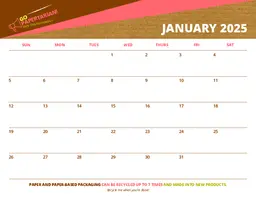
Getting ready to write out your New Year’s resolutions for 2025? Why not make this year’s resolution a green one and include a commitment to recycling and sustainability? After all, it is something we can all do and make a better future for ourselves and our planet.
But we have to do more than just say we are making a commitment to being greener. We need to hedge our resolutions by being SMART, which represents the gold standard of goal achievement, i.e., making resolutions specific, measurable, achievable, relevant and time-bound. What’s often missing is the “how”: how to implement these principles in setting goals for the new year, and how to make sure you’re sticking with them.
Checklists can make your resolutions not just SMART but intelligent (especially when done on paper) by ensuring that your plan will work. The checklist method of goal-making is simply breaking down each resolution with a checklist of steps that will help you achieve the overarching goal.
- Specific: Pay attention to the words you choose when writing your list. Start each item not just with an action verb, but with an actionable verb. For example, let’s say your goal is to recycle more, but you aren’t sure about the recycling rules in your area. Instead of the goal to "research recycling rules," be specific and write down "visit The Recycling Partnership for a list of recyclable items to print."
- Measurable: When you’re specific in your checklist, you also increase the odds of making your goals measurable. Who’s to say when you’re finished “researching” recycling rules? But you’ll know when you’ve printed a list of recyclable items. After you’ve written out your resolution checklists, thumb through all the pages and ask yourself at every point how you’ll know when each item is complete. If your answer is ever “I don’t know,” rephrase the item.
- Achievable: The checklist method helps you spot gaps in your goal-making so you’re not trying to go from 0 to 60 without a proper warm-up. The American Psychological Association recommends changing one behavior at a time, and checklists by nature are oriented toward exactly that—one item at a time.
- Relevant: Goals should be meaningful to you, like sustainability, and not something that’s decided on a whim or because it simply sounds like a good idea. The act of sitting down, pen in hand, to create your checklist inherently helps clarify what’s worthwhile to you. As Kathleen Adams at The Center for Journal Therapy puts it, the act of writing by hand in a journal creates what’s known as a “constant presence”: intimate, personal and relatable.
- Time-Bound: If your checklist is structured according to the principles above, it will lend itself to being naturally time-bound—that is, it will be a series of smaller goals that surge toward your larger resolution, which keeps your goal top of mind. So start with something small like reusing boxes to sort and separate various other recyclables, like plastic, glass and paper.
For items on your list that you’re resistant to finishing, assign a time limit. “If it’s something you’re really dreading, you could do it for just five or 10 minutes,” author and productivity expert Maura Nevel Thomas says. “Once we get started, we usually keep going—and if you don’t, you’ve still met your time goal with this bite-sized chunk.”









